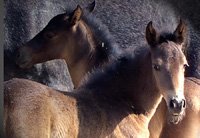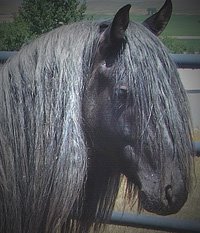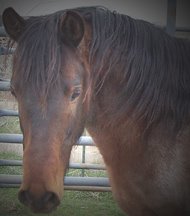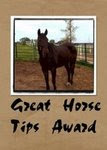
Born in late July, 2009, this Insider x Sandstorm filly reached a generous weaning age in mid-March. The time had come to separate her from Mama and begin the groundwork that will prepare her to go live with her new family in Oregon.
On weaning day, I was alone at In the Night Farm. No problem, I thought. After all, I designed my horse compound specifically for handling ungentled horses:
The round corral sits in the middle of a square enclosure. When swung outward, the round corral gate can be secured to the side of the square, creating a roadblock that funnels a loose horse right into the round corral for training. All my paddocks are arranged around the outside of the square, with gates that open into the square, so that any horse can be driven from paddock to round corral, no haltering required. So, it might take a little patience, but I should be able to separate Inara and Sandstorm without tremendous difficulty.
Well. The Inara-separation project required several steps involving moving Sandstorm to a spare paddock, then Inara to the round corral, then Sandstorm back to her original paddock, and finally, Inara into the spare paddock.
Sandstorm was easy. She knows the ropes.
Inara? A bit more difficult. Not only did she lack experience with the process of being moved from one pen to another, but her emotions skyrocketed the instant she realized Mama was neither by her side nor responding to her calls. Though Sandstorm's temporary paddock was located near the round corral gate, baby Inara was not excited about going in that direction. Instead, she raced frantically around the square enclosure.
Fortunately, the enclosure is a safe place for frantic racing. Its whole purpose, after all, is to contain wild horses. I waited several minutes for her to settle down, then approached her in a firm but non-threatening manner, asking her to move around the enclosure toward the round corral gate.
Normally, this works beautifully. It's a simple matter of asking a horse, in horse-language, to move in the desired direction.
But Inara wasn't listening. She blasted past me, alarmingly close and fast. I worked my way around and tried again, more forcefully, and prepared to back up if she approached so as to lessen the pressure without letting her by again. No dice. She blasted past.
 Oh really, I thought. That's interesting...not to mention a bit disturbing. After all, everything you do with a horse is training, and the last thing you want a horse to learn right out of the gate is that it doesn't have to surrender space to you.
Oh really, I thought. That's interesting...not to mention a bit disturbing. After all, everything you do with a horse is training, and the last thing you want a horse to learn right out of the gate is that it doesn't have to surrender space to you.Thankfully, my third attempt was successful. I closed the round corral gate on Inara, figuring that behind 7-foot, 12-gauge panels was the safest place for her at the moment, and sat down on the ground to study her and think.
Where had I gone wrong? What was happening in her little head? And how could I be sure it wouldn't happen again?
Slowly, as I watched her fling herself about the round corral -- pressing her ears back every time she passed me, which I found both fascinating and alarming since she has no reason for animosity -- I formed several conclusions:
1. Part of the problem I'd encountered in attempting to drive Inara had simply been her high emotional level. She was, understandably, panicky and preoccupied with Sandstorm's absence. However, blowing past me still represented a dramatic and willful move.
2. Inara comes from strong-willed stock. Barbs in general, and her sire in particular, have no shortage of courage or willingness to defend their own interests. An admirable trait, this, but certainly one to channel appropriately, for safety's sake.
3. Most enlightening of all was this: Inara has spent her entire life in a paddock with only her mama. She's never had another horse demand that she give way. Like most dams, Sandstorm has docilely tolerated Inara's youthful whims without reprimand. As far as Inara knows, it's perfectly acceptable to run roughshod, like a spoiled child, over anybody who gets in her way.
And there was my answer. The best thing I could to for Inara was to recruit a better trainer than myself -- another horse.
Consolation struck me as the ideal choice. Calm and confident, dominant but not a bully, firm but fair, I knew she'd put Inara in her place. So, after giving Inara a day to get over the worst of her weaning angst, I moved Consolation into her paddock with her.
Sure enough, Inara spent the next few hours learning that life isn't all about getting her way. Better than the most expert human trainer, Consolation used as much force as necessary -- but not a hint more -- to put the filly in her place.
It worked. During Inara's and my first gentling session a few days later, she tried to get past me...once. My body language -- now that Inara could read it and was calm enough to do so -- convinced her that the best direction to go was the one in which I sent her. We had a short but productive session, an unquestionable win, simply because she had learned to lose.
 _________________________________________________________
_________________________________________________________Want to read more posts like this one? Subscribe to The Barb Wire









9 comments:
Brilliant.
:)
You know the one about wise king Solomon and the bees?
If not, I'll tell you sometime.
sj
It does work! After a short period of time (when a foal is born), I put he/her and mom out with the other horses. It is so natural for them to be in a herd situation...also, the foals always learned to relate to the other horses and ended up feeling secure in the group.
You are very good at reasoning!
Poor little Inara learned a very important lesson--that she will survive without Mama. I love her comment on the whole thing!!!
Excellent post--love the lesson but hate the title! I started reading this with trepidation. What would I find?
You didn't lose and neither did Inara--or Consolation, for that matter! Everybody WON! Choosing Consolation to do a little of the work for you was an inspired decision.
The herd is the best teacher--like preschool. You are so gifted at this--as evidenced by all your success. Don't think you have lost anything.
SJ -- I know I've heard it...but it escapes me at the moment. I'm listening. :)
Hi Lori! Another good one: put a young stallion out in a herd of BRED mares. No better way for him to learn manners!
Phaedra -- LOL I couldn't resist adding that photo of the wee beastie.
Right you are, Pema. Nobody lost at all...even Inara, in the end. :)
Wonderful! I love how you thought it all through.
Our barn is no longer a breeding barn, but when it was, the babies were routinely put into pasture with an older gelding who put up with nothing, taught them manners, but never used a bit more force than necessary. They respected him, some loved him, and all came away with excellent manners. While they could get rambunctious, they set their baseline calmness level to his, which was very calm.
Nice work!
Jane
Jane
Come to think of it, perhaps our children might benefit from just such a turnout scheme.
Jane -- Ah, those older, steady geldings. Worth their weight in gold, over and over again.
Pema -- Perhaps that accounts for the popularity of elementary school janitors. :)
I really enjoyed this post and agree with what you deduced.
Post a Comment